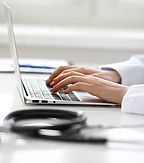Article | 17 May 2017
Two new regulations for medical devices

Two new regulations for medical devices enter into force in 2017. The purpose of the new regulations is to promote cross-border trade and innovation and to strengthen patient safety. The first regulation concerns medical devices which is to replace Directive 90/385/eeC on active implantable medical devices and Directive 93/42/ eeC on medical devices. The second regulation is concerning in vitro diagnostic medical devices.
The new regulations are directly applicable in all the Member States and are expected to enter into force during the second quarter of 2017. The new rules for medical devices will not need to be applied until three years later. The rules for in vitro diagnostic medical devices will not need to be applied until 5 years after the regulation has entered into force. As a result, current Swedish rules will be re-written, and in many cases repealed and replaced by the new rules.
However, for those of you who are affected by the new rules it is a good idea to start taking account of the changes now so that the implementation process is not as noticeable in your organisation. A broad summary of the new rules follows below.
Scope
Under the rules contained in the regulations, requirements will be set not just for manufacturers of the medical devices concerned but also, for example, for distributors, importers and authorised representatives. All medical device companies may be affected, but it is in vitro diagnostics (IVD) companies in particular that will need to adapt, partly because significantly more of these companies will need to make use of a notified body. The changes will also mean that some new products are covered by the regulatory framework, for example syringes prefilled with human collagen, dermal fillers and coloured contact lenses for cosmetic purposes.
Increased requirements and increased review
Implementation of the new rules will lead to increased review of medium- and high-risk devices. Among other things, the changes will mean that responsibility for evaluation falls on the Member States and the European Commission. The changes will also mean increased requirements for quality management and market follow-up. In addition to this, the requirements also increase for clinical data for the CE-marking of medical devices and for clinical follow-up after the device has been placed on the market.
The changes also result in further requirements to be met by distributors, as they have to check, for instance, that the device bears the CE-marking, that the declaration of conformity has been prepared, that the manufacturer’s information has accompanied the device and that the importer fulfils specified requirements. In addition, there are requirements for larger companies that manufacture medical devices to have a person with regulatory expertise within the organisation.
A coordination group for medical devices will be set up for the purpose of improving coordination between the national supervisory authorities. This is to ensure that only safe devices circulate on the EU-market.
Notified bodies
Notified bodies are to issue certificates for medium- and high-risk products before they are introduced on the market and check safety and performance when they have been placed on the market. In addition, notified bodies can make unannounced inspections and carry out physical checks or laboratory tests on devices.
The four risk classes for medical devices are still to apply, but the risk classification is to be adapted to technical development and experience from vigilance and market surveillance. For class I devices the manufacturers have to take responsibility themselves for the assessment of compliance. If the class I devices have a measuring function or are sold in sterile conditions, however, a notified body must inspect the device. With regard to devices in classes IIa, IIb and III, a notified body has to take part in inspection to a suitable extent in relation to the risk class. Devices in class III must be approved by the notified body before being placed on the market.
Traceability
The traceability of medical devices is to be improved. Among other things, a system for unique device identification (UDI) is to be introduced. UDIs are to be stored by the healthcare system and used for example in the event of accidents to identify manufacturers. Manufacturers and importers are therefore to provide their devices with a unique device identification, register themselves in a central EU database and be able to specify who has supplied a device and to whom they have supplied a device. However, it will not be up to the Member States themselves to assess whether distributors are to be registered.
Importer is understood to mean the operator who imports the products into the EU-market, and not the operator who imports articles within the EU. To enable importers to be contacted, importers have to state their name, registered office and address on the device or packaging or other accompanying documents.
In addition, manufacturers of implants have to provide the patient with information regarding device name, serial number, UDI, name and address of the manufacturer, warnings, precautions, expected product life and other information needed to enable the device to be used safely.
Reconditioning of certain disposable products
The proposal makes it possible for certain disposable products to be reconditioned. However, it is up to the Member States themselves to decide whether to permit such reconditioning. In the event that reconditioning is permitted, this is regarded as manufacturing of new devices, and the reconditioner therefore has the same obligations as a manufacturer.
Expansion of the European Database on Medical Devices, EUDAMED
The European Database on Medical Devices, EUDAMED, for medical devices is to be expanded to provide access to information, among other things, on use of medical devices available in the EU. Economic operators, notified bodies and sponsors will also gain access to the information they are considered to need to fulfil their obligations. The general public are also to have access to adequate information about devices and operators through this database, which is to contribute to greater transparency and safety.
We are, of course, here to answer any questions you might have.


